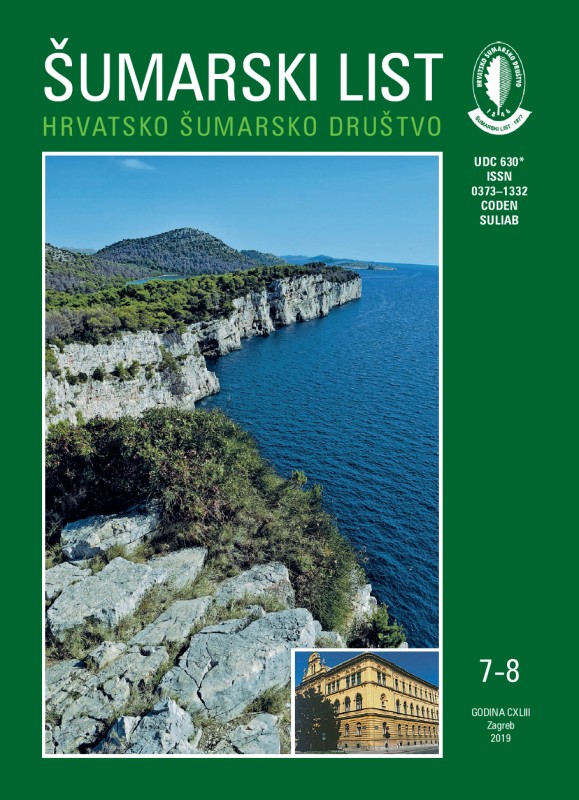
broj: 7-8/2019
pdf (13,1 MB) |
|
||||||||||||||
| RIJEČ UREDNIŠTVA | ||
| Uredništvo | ||
| Civil initiative to engage in collective tree planting on October 25, 26 and 27 pdf HR EN | 293 | |
| IZVORNI ZNANSTVENI ČLANCI | ||
| Joso Vukelić, Irena Šapić, Giacomo Mei, Igor Poljak, Ivana Plišo Vusić, Marko Orešković | UDK 630* 181.6 + 272 (001) https://doi.org/10.31298/sl.143.7-8.1 | |
| Black alder forests (type 91E0* Natura 2000 type E.2.1.9. NHC) in the Plitvice Lakes National Park pdf HR EN | 295 | |
| A. Paletto, T. Laktić, S. Posavec, Z. Dobšinská, B. Marić, I. Đordjević, P. Trajkov, E. Kitchoukov, Š. Pezdevšek Malovrh | UDK 630* 907 + 585 (001) https://doi.org/10.31298/sl.143.7-8.2 | |
| Nature conservation versus forestry activities in protected areas - the stakeholders’ point of view pdf HR EN | 307 | |
| Daniela Pilarska, Manana Kereselidze, Gernot Hoch, Andreas Linde | UDK 630* 453 (001) https://doi.org/10.31298/sl.143.7-8.3 | |
| Spore viability of microsporidian species isolated from gypsy moth larvae (Lymantria dispar) after long-term storage in liquid nitrogen pdf HR EN | 319 | |
| Ender Bugday, Abdullah Emin Akay | UDK 630* 383 + 686 (001) https://doi.org/10.31298/sl.143.7-8.4 | |
| Evaluation of forest road network planning in landslide sensitive areas by GIS-based multi-criteria decision making approaches in Ihsangazi watershed, Northern Turkey pdf HR EN | 325 | |
| Velid Halilović, Jusuf Musić, Muhamed Bajrić, Dževada Sokolović, Jelena Knežević, Amer Kupusović | UDK 630* 453 https://doi.orig/10.31298/sl.143.7-8.5 | |
| Fuel and lubricants consumption during timber felling and processing in the area of p.j. Forest office „Zavidovići“ pdf HR EN | 337 | |
| Zdravko Dolonec | UDK 630* 148.2 (001) https://doi.org/10.31298/sl.143.7-8.6 | |
| Nestbox occupancy by the great tit (Parus major L.) in young deciduous forest stands pdf HR EN | 347 | |
| SUMMARY Conservation of the biodiversity of the forest ecosystems is becoming one of the priority issues in the forest management. Birds play an important role in the overall life of the forest ecosystem, for instance, as an important component of the trophic chains. Recent studies worldwide suggest decline in the population size and richness of the forest bird species, especially those nesting in the cavity of the forest trees. Special emphasis is placed on the secondary cavity nesters. In contrast to the primary cavity excavators, which are making a tree cavity by themselves, secondary cavity nesters for their nesting use cavities made by the primary cavity excavators or natural cavities formed by gradual wood decay process. In order to maintain bird diversity in the forests with a lack of nesting cavities, installation of the nestboxes is an important strategy in many countries. This applies mainly to young deciduous, coniferous stands, and monocultural plantations and areas afforested with exotic tree species. In this paper, occupation of the nestboxes in the young deciduous stands was investigated. According to some researchers, the colour of the nestbox and its height above the ground could be important factors of the nestbox occupation in some bird species. In this study, a total of 120 standard wooden nestboxes were used (60 green and 60 brown). Nestboxes were installed in pairs on a single tree, at a height of 4.0 to 4.5 m (“high” position) and 2.0 to 2.5 m (“low” position). On the first tree, the green nestbox was in the “high” position, on the next tree in the “low” position and so on. The aim of this study was to determine the degree of occupancy of the nestboxes with a respect to the colour and the position on the tree. Because of the intra- and interspecific competition, only one of the nestbox pair was inhabited. Of the total 60 nestbox pairs, 44 (73.3%) nestboxes were occupied; 35 (79, 5%) by a Great Tit (Parus major) and 9 (20.5%) by a Blue Tit (Cyanistes caeruleus). Great Tits occupied mainly “green” nestboxes (88.6%), with no significant differences in the height position of the chosen nestbox. In conclusion, the colour of the nestboxes is more important factor than the height position on the tree during the occupation of the nestboxes by a Great Tit. Key words: Great Tit; Parus major; secondary cavity nesters; nest-box occupation; young deciduous forest | ||
| PREGLEDNI ČLANCI | ||
| Damir Klobučar, Silvije Orsag | UDK 630* 906 + 766 https://doi.org/10.31298/sl.143.7-8.7 | |
| Analysis of using a financial leverage in company „Hrvatske šume“, Ltd pdf HR EN | 353 | |


